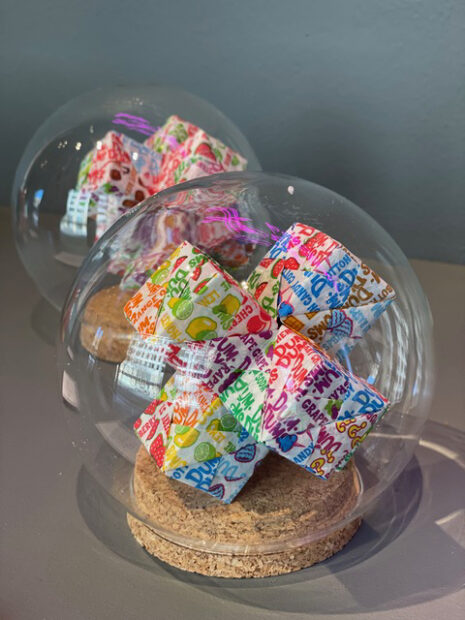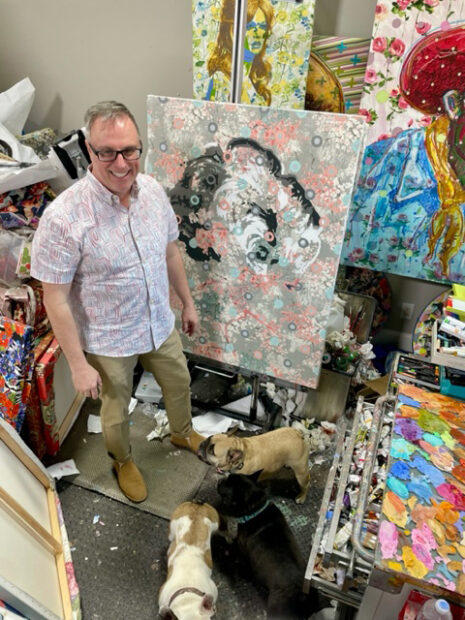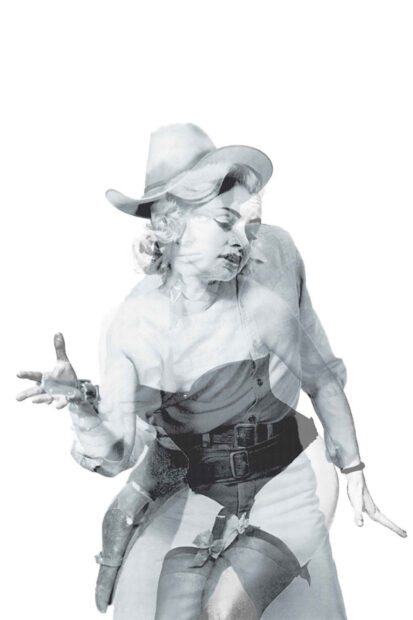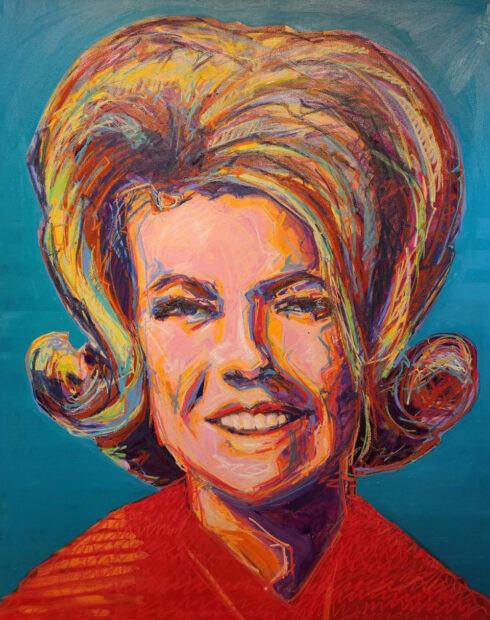There is a jaunty genius to B. Shawn Cox’s postmodern depictions of vintage cowboys and girls — so Texas it transcends Texas. From Warholian portraits of beauty queen bouffants to holographic duets between burlesque dancers and buckaroos, the work dabbles in a slick critique of social constructs (and constraints) that have helped shape the American mythos.
A certain do-si-do of derring-do takes place, with strong-jawed stockmen painted upon bright floral fabric and little darlins’ doing the gun slinging. With his lenticular prints, Cox blurs such characters into a single cyclopic entity (often joined at the holster). Paper constructions made of candy wrappers tap into the sacred geometry of saccharine-sweet lunacy — the empty calories of nostalgia — that so often fuels Westward identity.
On the spurs of his solo show, Bouff! – The Big Tease, at Davis Gallery in Austin, I paid Cox a visit at his home studio, where I was regaled by a three-ring circus of French Bulldogs while chatting and sifting through the artist’s wonder of clutter. (I also learned what the “B” stands for.)
Barbara Purcell (BP): Your work is both whimsical and whip smart as it playfully questions masculinity, beauty, even Manifest Destiny. Do you mean to be subversive or is it simply a fun byproduct of our cultural dissonance?
Shawn Cox (BSC): There’s a campiness and lightheartedness to it, but also an edginess and odd sexiness. I try to put people in little boxes that make consumer sense or commercial sense. Especially in the 1950s, when you did the right thing all the time — you wore the right hair, the right clothes, went to church, went to college. It all perpetuated this American Dream by creating an economy and reality that was easy to manage, easy to control…but the reality was something very different.
We’ve always had these crazy spectrums that swing back and forth from a political and socio-economic standpoint. It fascinates me how now, in my mind, things seem very polarized and how some of this same iconography is appropriated and readapted by both sides. I like playing in the middle, to step back and to be as objective as I can. But I suffer from pretty, I want it to be attractive — the composition, the colors — I want it all to come together.
BP: Your lenticulars are a great metaphor for this because they make the viewer look at the work from different sides — both physically and psychologically.
BSC: I agree, the lenticular is a perfect little tool to tweak flat work into something dimensional, a portal that’s pulling you into this other world in a soft way.
BP: What exactly is a lenticular?
BSC: It’s essentially an advertising product. I use a company in New York; they take each image, sliced vertically, and collate them completely digitally to create the composite. They put a lens on top of it that only lets you see a little at a time, so your brain does all the work. The Duality ones are two, that’s how I started; the ones in the second gallery [in Bouff!] are three composite images merged together. There’s something about three that’s really ephemeral. They can do up to 20! But there’s a fine line where you lose it and it becomes something else.
BP: You’ve been making geometric paper designs as of late, too — the small sculptures made out of Dum-Dums lollipop wrappers come to mind. First off, does your dentist approve?
BSC: I don’t really like Dum-Dums. I’m a savory person. But I like their smell and the colors are great.
BP: And yet, when I look at those Dum-Dums, displayed in their little glass jars, something dark seems to be going on.
BSC: My wife said they look like they’re pinned down, so it’s that artifact of something you create that’s fun and beautiful. It’s the same idea as butterflies, where you want to study it and hold it in a box. It’s unfortunate in a way that they’re in a container because they smell fun — Dum-Dums have that weird fake candy sucrose smell. They’re not what they really seem — just like the cowboys are not what they really seem. They’re fake cowboys. And the burlesque is an amplified version of female beauty and seductiveness. These facades are all playing with each other.
BP: How did the bouff motif come about?
BSC: My dad was the Marlboro Man, a rancher who was 6’ 4” with jet black hair and talked like he had marbles in his mouth. Mom was a beauty queen — they were high school sweethearts! The main bouffant portrait [The Matriarch (2023)] in the show is her junior year photo from their annual, or yearbook. I was also looking at her classmates in that book — people whose hair I thought was interesting — so it all grew out of that idea. I had been working on something called Playing With Lenticulars and I did a collage where I alternated their two pictures, and it looked just like me. Where the cowboys are my dad, the bouff became my mom — it’s a celebration of his life and hers. My dad passed away six years ago and the irony is that she now runs the ranch.
BP: Where did you grow up?
BSC: I was born in Lubbock when my parents were in college. They had my brother and me, but were able to finish their Master’s degrees quicker at Sul Ross [University] in Alpine before ending up in Monahans, Texas. It’s an old oil town, where Texas does that right angle with New Mexico. There was a boom-bust cycle, but when I graduated in 1986, from that point on, those little oil towns did not recover. Everything moved to Midland or San Angelo.
Our family ranch is in Garden City — let me give you the Berry story! John Berry and Lucy Berry owned the family ranch right outside of Garden City, in the middle of nowhere, and they had three daughters, so the Berry name died. They named most of the men Berry: Berry Gordon, Berry Steven, Berry Shawn, Berry Todd. My dad was Berry, so that’s where that came from. Quirky little family things like that are very west Texas.
BP: What was your high school like?
BSC: My parents were school teachers and I had them both when I was a student. Mom was English lit and Dad was chemistry and physics. I was a rancher kid and an academic kid — debate, speech, typing, all those things. I was expected to be a good student, but we had cattle and sheep and would go to stock shows all over Texas. Kinda bizarre to think of it now with my own kid, it was just a different time [laughs]. We’d take a week off from school and go drive and set up our little campground and show the sheep, then come back and do debate and speech. High school was a good experience because I had to do everything.
BP: And to prove that point, you pursued degrees in both architecture and law!
BSC: [Laughs.] I loved architecture school [at Texas Tech], but I graduated in 1991, and everything was shut down in a recession. Again, it’s those two sides — the arty technical side and the argument literature side — so I took the LSAT.
BP: Back to back in Lubbock?
BSC: I worked for two years as an architect. Did an internship in LA in mall architecture which was really fun — very LA — kiosks and storefronts in malls. Late ‘80s, super poppy. Then I got a job in Victoria at a little firm doing additions to the community hospital and schools, which was very near and dear to my heart. Then I went back to Lubbock for law school. I started off at a small firm there, then went to Dallas, then got recruited to NextTel, then telecom busted. I got married and eventually ended up here in Austin at Keller Williams doing their corporate stuff.
BP: How did you go from drawing up contracts to, well, drawing?
BSC: We had a nanny apocalypse! Our nanny was having some life transitioning issues at the time, so I became the primary caregiver. As my daughter Isabelle became more independent with school, I started doing more and more, like EAST and WEST [Austin Studio Tours].
BP: Your first show was in 2017 and things have moved pretty quickly since, even with COVID.
BSC: The last two years have been insane. COVID made me introspective. I was having less interaction with the outside, so it took me out of a commercial mindset and into let’s experiment and explore and take a little more time. The [paper] folding manifested during that time. I can fold anywhere. I just take my little baggie and fold away, I can watch Netflix and make my modules, and then create the pieces — that quilting concept — from the modules.
BP: Did you take art classes as a student?
BSC: I had a minor in art with a focus on, of all things, ceramics. But I did take painting classes and my wife has a lot to do with that. Whenever we travel, if we find an artist whose work is interesting to me, she gets me a workshop with them as my Christmas present. There’s this artist in Idaho, Robert Moore, he gives this one-week workshop for people of all levels and basically teaches Painting 101 to Business. I’ve taken it three or four times. I’m the antithesis of what he normally gets — he’s a regional landscape artist with an impressionist style, but wonderfully insightful. Of all things, a plein air painter has been a definite catalyst for what I create [laughs]. I gained all these little bits and fragments, like learning how to paint Aspen trees, but he was also very generous and open to discussing my figurative work and talking on a business level.

Installation shot of “At the Crux of Empty Calories (1 & 2)”, 2023, 5 x 5 inches. Photo by Barbara Purcell
BP: What’s the best piece of advice he’s given you?
BSC: Price by the inch.
BP: Your floral fabric canvases are super nostalgic. Did you grow up in a house decorated like that?
BSC: My dad’s parents were farmers and they struck oil, so they came into some money. And so my grandmother Edna redecorated a lot. Every time we’d go visit, there would be something new and I think that imprinted on me — new upholstery, new pillows, a new look: modern, mod, puffy, textural. Also, growing up, we made everything! My mom made all our clothes when we were little. We were far from poor, but we were not wealthy people by any stretch of the imagination. We lived on a 10-acre plot outside of town and grew things and built things and had cows and sheep and horses.
BP: What kind of music do you listen to?
BSC: I grew up on country. In high school I veered off with Depeche Mode when electronic music first came out.
BP: “Enjoy the Silence” in Far West Texas?!
BSC: And then the edgier stuff like Craftwork and BauHaus. The Smiths when I got to Lubbock. Now it’s whatever is playing on the radio. I just crank — to get it done, I have to be a machine.
BP: If we were to create a Venn Diagram of architect, attorney, and artist, what would be in that gooey candy center?
BSC: They’re all problem solving. Either in words or materials or visuals. In their own way, they’re all communicating some type of resolution.
This interview has been edited for clarity and length.
B Shawn Cox: BOUFF! The Big Tease was on view at Davis Gallery in Austin from January 14 – February 25, 2023.







1 comment
Fabulous and inspiring interview!